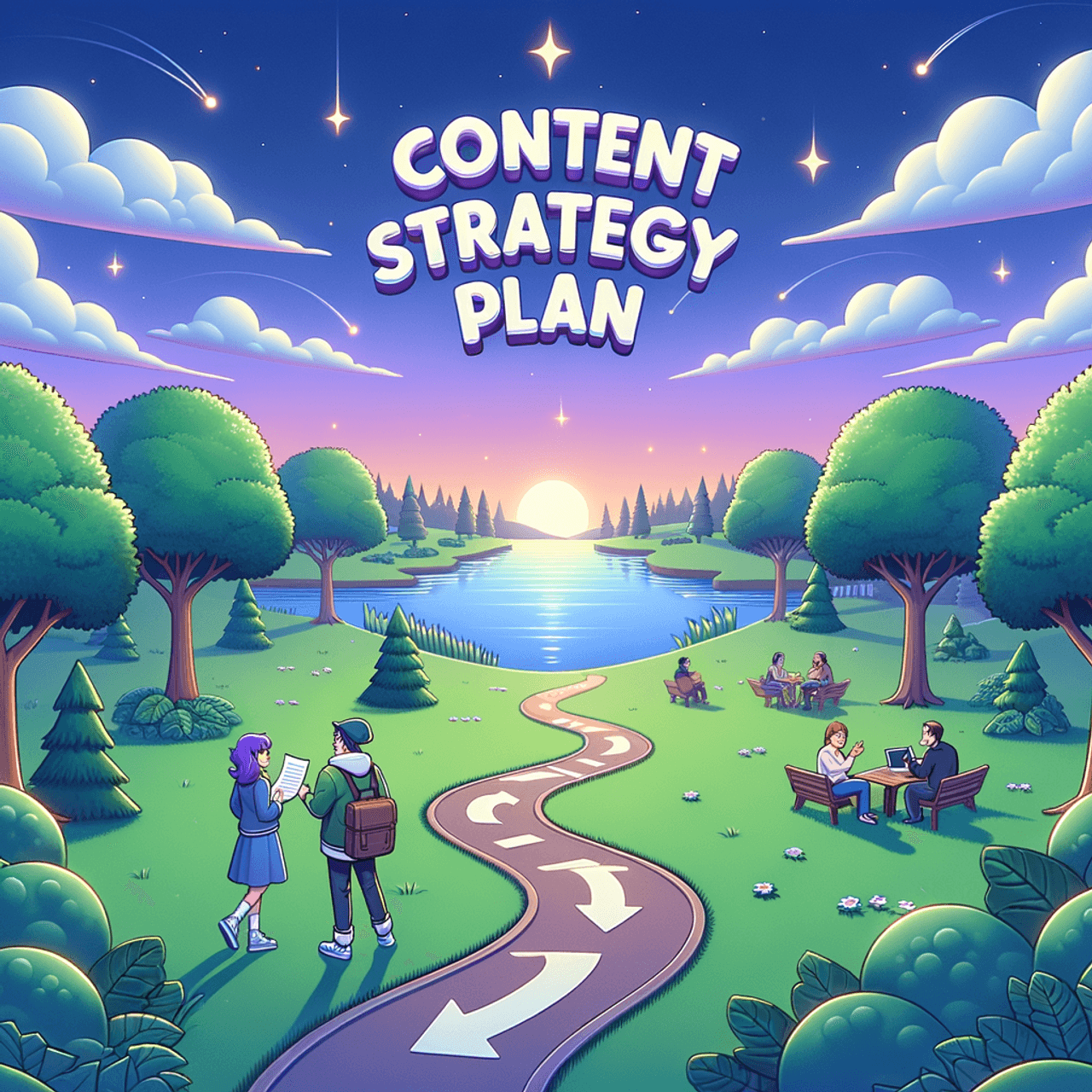by ContentERP | Oct 13, 2024 | Uncategorized
How to Boost Traffic by Automating Your Content Flow: A Guide with a Twist

The Case of the Disappearing Socks
Picture this: You’re late for work, and as usual, you can’t find a matching pair of socks. You swear you put them in the drawer last night, but now, they’ve vanished into some mysterious void. After a frantic search, you settle for a mismatched set and rush out the door, hoping no one notices your fashion faux pas. It’s a frustrating scenario, but one that perfectly mirrors the plight of many content creators. You spend hours crafting the perfect article, meticulously placing it online, only to watch it disappear into the vast abyss of the internet, with only a trickle of traffic coming your way.

But what if there were a way to automate the process and ensure your content always finds its perfect match? Like a magical sock sorter that not only finds the missing pieces but pairs them perfectly every time. Enter content flow automation—a system that not only saves time but also supercharges your website’s traffic.
1. The Content Conundrum: A Modern-Day Gordian Knot
In a digital world brimming with billions of web pages, boosting traffic can feel like trying to untangle a Gordian knot. But what if you could slice through that knot with a single, strategic move? Content flow automation might just be your sword.
Imagine your content as a river. Manually creating and distributing posts is like building a dam and releasing water in controlled spurts. Sure, it works, but it’s labor-intensive and leaves room for human error. With automation, however, you create a steady, self-sustaining current that keeps your content flowing smoothly, continuously driving traffic to your site. No more sporadic spurts—just a consistent stream of visitors.
2. Why Manual Content Management is Like Herding Cats
Trying to manage content manually is like herding cats. Each post, article, and video is an unpredictable feline with its own agenda. You think you’ve got them all lined up in a neat content calendar, but suddenly, one piece darts off into the underbrush of a missed deadline, while another climbs the curtains of forgotten promotion.
Automation tools like ContentERP help you wrangle these rebellious elements. They schedule posts, update old content, and even suggest new topics based on trends, ensuring your content ecosystem remains as orderly as a well-behaved litter.
3. Google Analytics: Your Crystal Ball of Traffic Insights
Before we dive deeper into the mechanics of automation, let’s talk about the foundation of boosting traffic—knowing your audience. Google Analytics is like a crystal ball for website owners. With a quick Google Analytics log in, you can peer into the depths of your audience’s behaviors, uncovering insights like which pages they love, where they lose interest, and even what devices they use.
But merely knowing isn’t enough. This is where automation can transform insights into action. Tools that integrate with Google Analytics can automate reports, set up alerts for traffic drops, and even suggest optimizations. Instead of drowning in data, you’re surfing the waves of actionable insights.
4. SEO Automation: The Magical Incantation for Traffic Growth

Search Engine Optimization (SEO) is like casting a spell to summon visitors from the depths of the internet. But casting spells manually is exhausting (just ask any wizard!). Automating your SEO strategy can turn this tedious process into a powerful incantation.
Tools like ContentERP can help you weave SEO into every piece of content you create, offering search engine optimization examples that align with current trends and best practices. From keyword research to meta-tag management, automation ensures that every post is optimized to charm search engines and attract readers like moths to a flame.
5. The Traffic Surge: It’s a Bird, It’s a Plane—No, It’s Automation!
Once your content flow is automated, you may experience a phenomenon known as the “traffic surge.” Picture your website as a quiet small-town airport. You’ve got a few visitors coming and going, and you’re comfortably managing the flow. But then, automation turns your humble terminal into a bustling international hub, with jets of traffic landing and taking off at all hours.
To handle this, make use of a reliable website traffic checker. This tool will help you monitor the surge, track new visitors, and analyze where they’re coming from. With a solid grip on your traffic patterns, you can adjust your automated strategies to keep the momentum going.
6. Google Search Console: The Overseer of Online Health
Think of Google Search Console as your website’s personal trainer. It keeps tabs on your site’s performance, pointing out strengths and weaknesses. By automating the process of monitoring your site’s health, you can receive regular updates on things like crawl errors, indexing issues, and keyword performance without lifting a finger.
Linking your automation tools to Google Search Console ensures your site remains in tip-top shape, always ready to welcome a flood of new visitors. After all, you wouldn’t invite guests to a party in a messy house, right?
7. ContentERP: Your Digital Quarterback
At the heart of a successful automated content strategy is a robust tool like ContentERP, which acts as your digital quarterback, calling the shots and coordinating every play. It integrates with your content management system, social media, SEO tools, and analytics platforms, ensuring every piece of content is created, optimized, and distributed with precision.
ContentERP can automate everything from blog posts and newsletters to social media updates and analytics reports. By freeing you from the minutiae of content management, it gives you more time to focus on strategy and creativity—the elements that truly set your brand apart.
8. Setting Up the Perfect Automation Workflow: A Step-by-Step Guide
Creating an automated content workflow is like baking the perfect cake. You need the right ingredients, tools, and a well-tested recipe. Here’s a simplified recipe to get you started:
Ingredients:
-
ContentERP
-
Google Analytics and Google Search Console accounts
-
A list of evergreen content ideas
-
A generous sprinkle of SEO keywords
Recipe:
-
Preheat Your Strategy: Define your goals. Are you looking to increase traffic, boost engagement, or convert leads?
-
Mix in the Content: Create a repository of evergreen content that can be shared multiple times.
-
Sprinkle in SEO: Use automated SEO tools to ensure every piece of content is optimized.
-
Bake with Automation: Schedule your posts, track performance, and adjust as needed based on analytics data.
-
Garnish with Insights: Regularly review automated reports to refine your strategy and keep your traffic growth steady.
The Paradox of Automation
And there you have it—a recipe for boosting traffic by automating your content flow. But here’s a question to ponder: If you automate everything, do you still get the credit for the traffic boost? It’s like setting up a Rube Goldberg machine that makes you breakfast—sure, you set it in motion, but who’s really doing the work?

by ContentERP | Oct 13, 2024 | Uncategorized
Top 10 Strategies for Boosting Content Engagement Across Multiple Platforms
 In 1997, a small internet company named Amazon launched its first IPO, opening at a modest $18 per share. Back then, no one could have predicted that Amazon would grow into a global retail giant, revolutionizing how we shop, consume media, and even engage with content. The internet was still a wild, untamed frontier—digital strategies were almost as experimental as the dot-com companies themselves. But the rise of companies like Amazon signaled the future of content: engagement across multiple platforms.
In 1997, a small internet company named Amazon launched its first IPO, opening at a modest $18 per share. Back then, no one could have predicted that Amazon would grow into a global retail giant, revolutionizing how we shop, consume media, and even engage with content. The internet was still a wild, untamed frontier—digital strategies were almost as experimental as the dot-com companies themselves. But the rise of companies like Amazon signaled the future of content: engagement across multiple platforms.
Fast forward to today, and the rules of the game have drastically changed. Just as Amazon expanded from books to a wide range of products, content creators now face a universe of platforms—each with unique audiences, behaviors, and nuances. To thrive in this competitive landscape, you need more than just creativity; you need strategy. The following ten strategies, powered by ContentERP, will help you master the art of boosting content engagement across multiple platforms.
1. Tailor Content for Each Platform
The first rule of thumb: don’t treat every platform the same. Posting identical content across social media is like trying to fit a square peg into a round hole. Instagram demands stunning visuals, while Twitter thrives on brevity and wit. LinkedIn, on the other hand, values professional insight. To maximize audience engagement, your content strategy for social media must be customized for each platform.
With ContentERP’s intelligent scheduling tools, you can craft unique posts tailored to each platform without spending hours managing different accounts. By leveraging its content strategy for social media, your brand can speak to each audience in the way they want to be heard.
2. Use Visuals That Spark Emotion
 A picture is worth a thousand words, but only if it makes an impact. Visual content, when done right, can create an emotional connection with your audience. But if you’re merely adding images to fill space, you’re missing an opportunity. It’s about sparking curiosity, joy, or even a sense of urgency.
A picture is worth a thousand words, but only if it makes an impact. Visual content, when done right, can create an emotional connection with your audience. But if you’re merely adding images to fill space, you’re missing an opportunity. It’s about sparking curiosity, joy, or even a sense of urgency.
Imagine your content as a film. Just as great directors use cinematography to evoke emotions, your visuals should do the same. Whether it’s a high-quality photo, infographic, or video, ContentERP’s streamlined tools allow you to effortlessly integrate visuals that make your content resonate.
3. Consistency is Key
Rome wasn’t built in a day, and neither is a loyal online following. Consistency in posting is crucial to keeping your audience engaged. If you’re erratic with your publishing schedule, don’t be surprised if your engagement metrics look more like a rollercoaster than a steady upward curve.
This is where ContentERP shines. Its workflow automation ensures that your content calendar runs like clockwork, eliminating the peaks and valleys that come from inconsistent posting. With ContentERP, you can focus on quality while the platform handles the frequency.
4. Leverage Data-Driven Insights
Flying blind might work for stunt pilots, but it’s not a recommended content strategy. If you’re not analyzing your data, you’re missing out on valuable insights that could be driving higher engagement. Which posts are getting the most likes? What time of day do your followers engage most? Data is the flashlight that guides you through the jungle of audience behavior.
 ContentERP’s advanced analytics help you dive deep into your content’s performance, offering real-time insights into which strategies work and which need tweaking. Armed with this information, you can refine your approach and optimize content engagement across platforms.
ContentERP’s advanced analytics help you dive deep into your content’s performance, offering real-time insights into which strategies work and which need tweaking. Armed with this information, you can refine your approach and optimize content engagement across platforms.
5. Engage with Your Audience in Real-Time
Posting content is not a one-way conversation. Imagine being at a cocktail party where no one responds when you say something clever. That’s what happens when you post content and fail to interact with your audience. Engagement is a two-way street, and responding to comments, questions, and mentions is crucial.
With ContentERP, you can monitor audience interactions across all your platforms from a single dashboard, allowing you to reply swiftly and efficiently. In this way, your audience feels heard and valued—turning casual followers into dedicated fans.
6. Tell a Story
Storytelling is the backbone of human connection. A well-told story can transport people, evoke emotions, and—most importantly—make your content memorable. Whether you’re sharing a customer success story or revealing the journey behind your brand’s creation, stories have the power to engage in ways that mere information cannot.
 Think of your content like a novel: every post, tweet, or video is a new chapter. With ContentERP’s content management tools, you can seamlessly weave these chapters together to build a cohesive narrative that resonates with your audience.
Think of your content like a novel: every post, tweet, or video is a new chapter. With ContentERP’s content management tools, you can seamlessly weave these chapters together to build a cohesive narrative that resonates with your audience.
7. Incorporate User-Generated Content
The best way to build trust with your audience is to show them that others already trust you. User-generated content (UGC) is like the online version of word-of-mouth marketing. When people see real customers or fans engaging with your brand, they’re more likely to jump on board.
Encourage your audience to share their experiences with your product or service. Share their photos, testimonials, or reviews on your platforms. Not only does this foster community, but it also boosts your credibility—two essential elements of audience engagement.
8. Experiment with Different Formats
Variety is the spice of life, and that applies to content as well. Don’t be afraid to switch things up by experimenting with different content formats—whether it’s a live video, a blog post, a poll, or an infographic.
 ContentERP makes it easy to diversify your content. Its versatile tools allow you to create and promote content in multiple formats, ensuring your audience never grows tired of seeing the same old posts.
ContentERP makes it easy to diversify your content. Its versatile tools allow you to create and promote content in multiple formats, ensuring your audience never grows tired of seeing the same old posts.
9. Collaborate with Influencers
In the 90s, celebrity endorsements were the golden ticket to marketing success. Today, that influence has shifted to social media influencers. Collaborating with the right influencer can put your brand in front of thousands, if not millions, of potential customers.
Using ContentERP’s influencer tracking tools, you can identify key figures in your industry and forge partnerships that elevate your brand’s visibility and engagement.
10. Create Interactive Content
Today’s audiences crave participation. Interactive content—like quizzes, surveys, or polls—invites your audience to engage directly with your brand. It’s the difference between a passive viewer and an active participant.
 Think of interactive content as the life of the party. It’s the spark that turns a gathering of strangers into a lively event. With ContentERP, you can easily create interactive content that keeps your audience engaged and coming back for more.
Think of interactive content as the life of the party. It’s the spark that turns a gathering of strangers into a lively event. With ContentERP, you can easily create interactive content that keeps your audience engaged and coming back for more.
Conclusion: The Future of Engagement
As we march deeper into the digital era, it’s essential to remember the lessons of the past. Just as Amazon adapted and evolved in the 90s, today’s content creators must remain flexible and forward-thinking. Engagement isn’t a luxury—it’s a necessity for survival in an ever-expanding digital marketplace.
Yet, with so many platforms, tools, and strategies at your disposal, the challenge is daunting. That’s where ContentERP steps in, offering a unified solution to the complexities of content creation and promotion.
But as we look ahead, one question lingers: with these strategies in hand, how will you revolutionize your content engagement in 2024?
by ContentERP | Oct 13, 2024 | Uncategorized
Effortless Content Promotion with ContentERP: Best Practices for 2024
 Picture this: You’ve crafted the perfect blog post. It’s engaging, insightful, and poised to go viral—or so you think. But after hitting publish, the post seems to drift into the digital abyss, with barely a ripple in traffic. What went wrong? In today’s fast-paced online world, exceptional content is just half the battle. The real game-changer lies in promoting that content with precision and strategy. Enter ContentERP, your all-in-one solution for effortless content promotion.
Picture this: You’ve crafted the perfect blog post. It’s engaging, insightful, and poised to go viral—or so you think. But after hitting publish, the post seems to drift into the digital abyss, with barely a ripple in traffic. What went wrong? In today’s fast-paced online world, exceptional content is just half the battle. The real game-changer lies in promoting that content with precision and strategy. Enter ContentERP, your all-in-one solution for effortless content promotion.
As we move into 2024, content creators need more than good ideas; they need streamlined tools to amplify their reach. ContentERP takes the heavy lifting out of content marketing strategies, so you can focus on what matters: creating valuable content that resonates. But how can you use this platform to transform your content promotion game? Let’s explore the best practices that will make your content soar in 2024.
The Art of Content Promotion: Why It’s Essential
Imagine your content is like a meticulously crafted paper airplane. Without the proper launch—whether it’s the perfect gust of wind or a strategically thrown arm—it falls flat. The same goes for content. You can pour hours into the most insightful blog post, but if it’s not promoted effectively, it will fail to reach the audience it deserves. In a saturated digital landscape, content promotion isn’t just helpful—it’s vital.
Content promotion is about more than just getting eyes on your content; it’s about getting the right eyes. Targeting the correct audience with precision can turn passive readers into loyal customers. With ContentERP, promoting content has never been easier. This platform integrates all your content marketing strategies into one simple interface, offering everything from content research tools to social media automation, so your ideas can soar without you lifting a finger.
Best Practices for 2024: What ContentERP Brings to the Table
 1. Leverage Automated Promotion Tools
1. Leverage Automated Promotion Tools
Let’s be honest—promoting content manually across multiple platforms is like trying to juggle flaming torches. It’s stressful, and you’re bound to get burned at some point. In 2024, automation is king. With ContentERP, you can automate content promotion across various channels—Facebook, Twitter, LinkedIn, and more—with a few clicks. This frees up your time for creativity, while your content quietly circulates in the background.
ContentERP’s creative content strategy options allow you to schedule posts, promote at optimal times, and even track engagement metrics in real-time. Imagine effortlessly pushing your content live while sipping your morning coffee—ContentERP is your very own content marketing butler.
2. Create a Multichannel Strategy
The age-old mantra of “don’t put all your eggs in one basket” applies doubly to content promotion. Relying solely on one platform—whether it’s your blog, Instagram, or LinkedIn—limits your reach. A multichannel strategy ensures your content is seen by the largest possible audience.
With ContentERP, you can customize your promotion strategy to fit each platform. For example, you might opt for a punchy headline on Twitter, a detailed infographic on Pinterest, and a thought-provoking teaser on LinkedIn. Each post is tailored, yet seamlessly orchestrated through ContentERP’s content research tools and automated workflow. The result? More eyeballs, more engagement, and more conversions.
3. Optimize for SEO with Built-in Tools
If content promotion is the engine, then SEO is the fuel. Optimizing for search engines is one of the most effective ways to get your content in front of the right audience. But SEO isn’t just about sprinkling keywords into your copy like digital fairy dust—it requires research, strategy, and finesse.
 ContentERP integrates powerful SEO tools right into your content creation process. Its keyword research module helps you identify the most relevant search terms for your industry, ensuring that your content ranks highly on search engine results pages (SERPs). By using this built-in tool, you’ll no longer need to rely on guesswork. With content research tools, the days of aimlessly tossing around keywords are over. Instead, you can effortlessly weave in keywords like “content promotion” and “creative content strategy” to maximize your search rankings.
ContentERP integrates powerful SEO tools right into your content creation process. Its keyword research module helps you identify the most relevant search terms for your industry, ensuring that your content ranks highly on search engine results pages (SERPs). By using this built-in tool, you’ll no longer need to rely on guesswork. With content research tools, the days of aimlessly tossing around keywords are over. Instead, you can effortlessly weave in keywords like “content promotion” and “creative content strategy” to maximize your search rankings.
4. Engage with Your Audience in Real Time
Content promotion doesn’t end when you hit ‘publish.’ Engaging with your audience in real-time is critical for building a loyal following. Responding to comments, retweets, or shares makes your readers feel valued—and keeps them coming back for more.
Through ContentERP’s real-time analytics, you can track how well your content is performing and engage accordingly. See which platforms are generating the most buzz, which headlines are resonating, and who’s sharing your posts. It’s like having a bird’s eye view of your content’s success as it unfolds.
A Gateway to Your Content’s Future
Close your eyes for a moment and imagine this: the low hum of success vibrating through your workspace as your latest piece of content goes live. You watch the metrics climb steadily—engagement, shares, comments—all effortlessly managed through one elegant platform. No stress, no endless social media log-ins, no missed opportunities.
 This is the future of content promotion, and it’s well within your grasp with ContentERP. Like a symphony conductor guiding each note to perfection, ContentERP orchestrates your content marketing strategy from start to finish, ensuring that every post, blog, and video not only reaches the right audience but does so with precision and purpose.
This is the future of content promotion, and it’s well within your grasp with ContentERP. Like a symphony conductor guiding each note to perfection, ContentERP orchestrates your content marketing strategy from start to finish, ensuring that every post, blog, and video not only reaches the right audience but does so with precision and purpose.
The road to effortless content promotion begins here. Content creators, writers, marketers—whether you’re just starting out or looking to scale—ContentERP is your trusted companion on this journey. Imagine a world where your content doesn’t just sit idly in the void but instead takes flight, reaching new heights and new readers, effortlessly.
Make ContentERP Your Secret Weapon
So, why struggle through the maze of content promotion alone when you can have a guide? Sign up for ContentERP today and transform how you create, manage, and promote content. With streamlined workflows, advanced SEO tools, and real-time analytics, you’ll have everything you need to make 2024 your most successful year yet. Don’t just dream of reaching a wider audience—make it happen. Your content deserves to be seen, and with ContentERP, it will be. Join the future of content promotion today.
by ContentERP | Oct 13, 2024 | Uncategorized
Why Your Business Needs ContentERP for Seamless Content Production
 In the ever-evolving landscape of digital marketing, content is king, but without proper management, even the mightiest monarch can fall. As the old proverb goes, “A chain is only as strong as its weakest link,” and in the realm of content creation, that weak link often lies in disorganized production processes. Enter ContentERP, a revolutionary solution that promises to transform the way businesses approach content creation and management.
In the ever-evolving landscape of digital marketing, content is king, but without proper management, even the mightiest monarch can fall. As the old proverb goes, “A chain is only as strong as its weakest link,” and in the realm of content creation, that weak link often lies in disorganized production processes. Enter ContentERP, a revolutionary solution that promises to transform the way businesses approach content creation and management.
In today’s fast-paced digital world, companies of all sizes are realizing the importance of a robust content strategy framework. However, many struggle to keep up with the demands of consistent, high-quality content production. It’s like trying to drink from a fire hose – overwhelming and often ineffective. This is where ContentERP steps in, offering a lifeline to businesses drowning in a sea of content chaos.
But what exactly is ContentERP, and how does it differ from traditional content management systems? At its core, ContentERP is a comprehensive platform designed to streamline every aspect of the content creation process. It’s not just another tool in the toolbox; it’s the entire workshop, neatly organized and optimized for maximum efficiency.
For content creation companies, ContentERP is a game-changer. It serves as a central hub for all content-related activities, from ideation to publication and beyond. Gone are the days of endless email threads, lost documents, and missed deadlines. With ContentERP, every piece of content has a home, and every team member knows exactly where to find it.
One of the key benefits of ContentERP is its ability to facilitate collaboration. In the world of content production, teamwork is essential. ContentERP acts as a virtual watercooler, bringing together writers, editors, designers, and marketers in a seamless digital environment. It’s like having a round-the-clock brainstorming session, where ideas can flow freely and be captured instantly.
But ContentERP isn’t just about organization and collaboration. It’s also a powerful tool for strategy and analytics. For businesses looking to develop a robust content strategy framework, ContentERP provides invaluable insights into content performance, audience engagement, and ROI. It’s like having a crystal ball that not only predicts the future of your content but also shows you how to shape it.
 One of the most common questions asked by businesses considering ContentERP is, “What is a content producer, and how does this system benefit them?” A content producer is the unsung hero of the digital marketing world, responsible for creating and managing various forms of content across multiple platforms. With ContentERP, content producers can spread their wings and soar to new heights of productivity and creativity.
One of the most common questions asked by businesses considering ContentERP is, “What is a content producer, and how does this system benefit them?” A content producer is the unsung hero of the digital marketing world, responsible for creating and managing various forms of content across multiple platforms. With ContentERP, content producers can spread their wings and soar to new heights of productivity and creativity.
The system’s intuitive interface and powerful features allow content producers to focus on what they do best—creating compelling content – while the platform takes care of the rest. From automated workflow management to integrated SEO tools, ContentERP is like a Swiss Army knife for content producers, equipping them with everything they need to succeed in one convenient package
But perhaps the most significant advantage of ContentERP is its ability to adapt and grow with your business. As your content needs evolve, so too does the platform. It’s like planting a seed that grows into a mighty oak, providing shelter and support for your entire content ecosystem.
Of course, implementing any new system comes with its challenges. Some businesses may be hesitant to make the switch, fearing disruption to their existing processes. However, the transition to ContentERP is typically smooth and painless, with dedicated support teams on hand to guide you every step of the way. It’s like learning to ride a bicycle – once you get the hang of it, you’ll wonder how you ever managed without it.
The benefits of ContentERP extend far beyond the content team. For marketing managers, it provides unprecedented visibility into the content creation process, allowing for better resource allocation and strategic planning. For executives, it offers a bird’s-eye view of content performance across the entire organization, enabling data-driven decision-making.
As businesses continue to navigate the choppy waters of digital marketing, ContentERP stands as a beacon of hope, guiding them towards smoother sailing and greater success. It’s not just a tool; it’s a philosophy – a commitment to excellence in content creation and management.
In conclusion, the question isn’t whether your business needs ContentERP, but rather how soon you can implement it. As content continues to reign supreme in the digital realm, having a robust system in place to manage its creation and distribution is no longer a luxury – it’s a necessity.
Related: Your Dream Job in 4 Steps: How to Become a Brand Content Writer
by ContentERP | Oct 13, 2024 | Uncategorized
The Benefits of Using ContentERP for Effective Content Strategy Planning
When Content Plans Go Wrong: A Digital Disaster
Imagine this: you’re standing on a tightrope, 100 feet above the ground, holding a stack of papers in one hand and a laptop in the other. Below you is your team, frantically shouting instructions, each contradicting the next. Meanwhile, your boss is yelling, “We need more content! Post it now!” And somewhere, deep in the background, the sound of chaos: notifications, missed deadlines, and last-minute edits. That’s what trying to manage a content strategy without proper tools feels like. It’s not just overwhelming—it’s a disaster waiting to happen.
The digital landscape is unforgiving, and without a robust system in place, managing content can quickly spiral out of control. Poor planning leads to inconsistent branding, off-message posts, and chaotic workflows. In short, it’s like running a marathon in flip-flops—you’ll eventually cross the finish line, but not without a lot of stumbles and sore feet.
 ContentERP is the unsung hero of content strategy planning. Like a seasoned conductor guiding a full orchestra, ContentERP orchestrates every element of content creation, from brainstorming to publication, ensuring harmony at every stage. No more scrambling. No more chaos. It’s time to turn your content process into a well-oiled machine.
ContentERP is the unsung hero of content strategy planning. Like a seasoned conductor guiding a full orchestra, ContentERP orchestrates every element of content creation, from brainstorming to publication, ensuring harmony at every stage. No more scrambling. No more chaos. It’s time to turn your content process into a well-oiled machine.
Streamlining Content Strategy Planning
Let’s be honest: planning a content strategy without the right tools is like trying to build a house with a plastic spoon. Sure, you’ll get some dirt moved, but you’ll never make meaningful progress. ContentERP, on the other hand, equips content managers and creators with the metaphorical bulldozers and blueprints they need to streamline the entire process.
At its core, ContentERP provides a centralized hub where teams can collaborate, share ideas, and map out a cohesive content strategy plan. Think of it as a digital war room where every piece of content is meticulously plotted before being unleashed into the world. Whether it’s a blog post, social media campaign, or email blast, ContentERP lets you track every moving part, ensuring nothing falls through the cracks.
More than just a content calendar, ContentERP’s tools offer a full spectrum of management features: from content brainstorming to assigning tasks, setting deadlines, and reviewing drafts. It’s the glue that holds all the pieces of a content strategy together, ensuring that your brand’s messaging remains consistent and aligned with your broader business goals.
Content Frameworks: The Backbone of Great Strategy
 Imagine trying to build a skyscraper without a blueprint—chaos, right? Now, imagine trying to execute a content strategy without a framework. The result is the same: a scattered, inconsistent message that confuses rather than captivates your audience.
Imagine trying to build a skyscraper without a blueprint—chaos, right? Now, imagine trying to execute a content strategy without a framework. The result is the same: a scattered, inconsistent message that confuses rather than captivates your audience.
This is where ContentERP shines. At its heart, it offers a powerful content framework, a blueprint that allows your team to consistently create content that’s aligned with your brand’s vision and goals. Like a scaffolding that supports a building as it rises into the sky, ContentERP’s framework supports your content strategy, ensuring that each piece fits neatly into the larger narrative you’re trying to tell.
By using ContentERP’s content framework, teams can establish clear guidelines for tone, style, and messaging. It’s like a recipe for success, ensuring that no matter who’s cooking, the dish always tastes just right. Whether you’re creating branded content or informational articles, having a reliable framework ensures consistency and quality, which are the cornerstones of any successful content strategy.
Efficiency is Key: Saving Time with Automation
We’ve all heard the saying, “Time is money.” But in the world of content creation, time is also creativity. The more time your team spends on administrative tasks—tracking deadlines, managing approvals, organizing content—the less time they have for the creative work that really matters.
ContentERP’s automation features are like having an extra set of hands. It handles the routine tasks—like sending reminders, tracking revisions, and organizing files—so your team can focus on producing high-quality content. It’s like a magic trick where all the mundane work disappears, leaving only the creative, strategic side of content creation.
The platform’s content scheduling tools are a lifesaver for managing large-scale campaigns. No more scrambling at the last minute to post content across multiple channels. ContentERP allows you to plan ahead, schedule posts, and even automate publishing, so your team can stay focused on creating, rather than managing, content. It’s like having a personal assistant for your content strategy, always keeping things on track.
Breaking Down Silos: Improving Team Collaboration
Many companies struggle with content silos—where different departments work independently, with little to no communication. The result? A fragmented content strategy that fails to deliver a cohesive message.
ContentERP breaks down these silos by offering a centralized platform where all departments—whether marketing, sales, or design—can collaborate seamlessly. It’s like having an open-plan office where ideas flow freely, and everyone is on the same page. The platform’s collaborative features ensure that every piece of content is reviewed, edited, and approved by the right people before publication.
Data-Driven Decisions: Using Insights to Shape Strategy
In the world of content creation, guesswork is a luxury no one can afford. You wouldn’t navigate a ship without a map, so why would you build a content strategy without data?
ContentERP provides powerful analytics tools that allow you to track the performance of your content in real time. It’s like having a crystal ball that tells you what’s working, what’s not, and where to focus your efforts. The platform’s detailed insights allow you to make data-driven decisions, ensuring that your content strategy is always optimized for maximum impact.
By analyzing metrics like engagement rates, click-throughs, and conversions, ContentERP helps you fine-tune your content strategy, ensuring that every piece you publish moves the needle. It’s the difference between shooting in the dark and hitting the bullseye.
Keeping Your Brand Consistent: The Golden Thread
 One of the biggest challenges in content strategy planning is maintaining a consistent brand voice across multiple platforms. Without a unified approach, your brand’s messaging can become fragmented, leading to confusion among your audience.
One of the biggest challenges in content strategy planning is maintaining a consistent brand voice across multiple platforms. Without a unified approach, your brand’s messaging can become fragmented, leading to confusion among your audience.
ContentERP ensures that your brand’s voice remains consistent, no matter how many different platforms you’re using. It’s like a golden thread that weaves through every piece of content, tying everything together. Whether you’re posting on social media, sending out newsletters, or publishing blog posts, ContentERP ensures that your brand’s messaging is clear, cohesive, and on point.
The platform’s content templates and guidelines allow teams to easily maintain consistency across all channels. It’s like having a brand guardian, always ensuring that your content stays true to your brand’s identity.
Can Content Be Too Organized?
ContentERP makes managing a content strategy feel as easy as pie. It streamlines planning, automates tasks, fosters collaboration, and provides valuable insights to help you refine your approach. But here’s the real question: If your content is so perfectly organized, does it even need you anymore?
That’s the paradox ContentERP leaves us with—an effortless system that almost makes you wonder if it’s doing too good of a job. But hey, if the result is a well-oiled content machine, we’ll gladly take it!
by ContentERP | Oct 13, 2024 | Uncategorized
How ContentERP Helps You Manage Large Teams and Complex Content Strategies
 Some say managing large teams is like herding cats—an impossible task that leaves you feeling more like a zookeeper than a manager. Others argue it’s a breeze if you have the right tools in place, like a well-oiled machine humming along without a hitch. The truth, of course, lies somewhere in the middle. Managing large teams and executing complex content strategies is no small feat. It’s a juggling act that requires both organization and flexibility, and more often than not, things get messy.
Some say managing large teams is like herding cats—an impossible task that leaves you feeling more like a zookeeper than a manager. Others argue it’s a breeze if you have the right tools in place, like a well-oiled machine humming along without a hitch. The truth, of course, lies somewhere in the middle. Managing large teams and executing complex content strategies is no small feat. It’s a juggling act that requires both organization and flexibility, and more often than not, things get messy.
Enter ContentERP—the tool that transforms your chaotic circus of content creation into a streamlined process, where each team member knows their role, and every piece of content fits neatly into a broader strategy. Whether you’re running a content framework for a multinational brand or coordinating a content strategy plan for a small, but fast-growing startup, ContentERP helps you manage large teams and execute intricate content strategies with ease.
Herding Cats? Try Managing Teams Without a Strategy
Managing a team of creatives without a clear content strategy plan is like trying to build a house without a blueprint—you’ll end up with something, but it’s probably not what you intended. The larger the team, the greater the chaos. Ideas are flying, deadlines are missed, and somewhere along the way, the original strategy becomes a distant memory.
ContentERP addresses this problem by providing a robust content framework that allows teams to align on goals, timelines, and responsibilities. With a clear framework in place, you’re no longer herding cats—you’re guiding a focused, collaborative effort toward a common goal.
Imagine ContentERP as the conductor of a content orchestra. Each team member plays their part, but instead of a cacophony, you get a harmonious symphony of blog posts, social media updates, email campaigns, and more. Everyone knows their role and how it fits into the larger composition.
Breaking Down Silos: The Key to Complex Content Strategies
Large teams often fall into the trap of working in silos. Marketing is on one side, sales is on another, and editorial is somewhere in between—each department working on its own content strategies without understanding how it all fits together. The result? A disjointed brand message and scattered content that confuses rather than engages your audience.
 ContentERP helps break down these silos by providing a centralized hub where all content-related activities are coordinated. It’s like a GPS for your content strategy, showing every team where they’re headed and how to get there. No more wandering in different directions—everyone is on the same page, working toward the same goal.
ContentERP helps break down these silos by providing a centralized hub where all content-related activities are coordinated. It’s like a GPS for your content strategy, showing every team where they’re headed and how to get there. No more wandering in different directions—everyone is on the same page, working toward the same goal.
Through a combination of real-time collaboration tools and a powerful content calendar, ContentERP ensures that every piece of content—from blog posts to infographics—fits into the broader strategy. The system acts as a compass, guiding teams through the complexity of managing multiple content streams while keeping the overall brand message consistent and cohesive.
Flexibility Meets Structure: The Perfect Balance
Some managers swear by strict guidelines and rigid rules, believing that structure is the only way to maintain order. Others prefer a more flexible approach, allowing creativity to flow and ideas to evolve naturally. But why choose one when you can have both?
ContentERP strikes the perfect balance between structure and flexibility. It provides the scaffolding for your content strategy plan, ensuring that every piece of content has a place and a purpose. At the same time, it allows for creative freedom, letting your team experiment, iterate, and innovate within that framework.
Think of ContentERP as a roadmap. It shows you the route to your destination but lets you take detours if you find an interesting side road. The key is that you’ll always know how to get back on track, no matter where the creative process takes you.
Handling Volume Without Losing Quality
When managing large teams, it’s easy to prioritize quantity over quality. The pressure to produce more content—more blogs, more social media posts, more videos—can lead to a flood of material that, while abundant, lacks the polish and precision needed to make an impact. It’s the content equivalent of fast food: cheap, fast, and forgettable.
ContentERP ensures that your team can handle high volumes of content without sacrificing quality. By streamlining the review and approval process, it allows your team to focus on crafting content that’s not just good—but great. Every piece is carefully vetted, edited, and optimized for its intended audience, ensuring that your brand message is sharp, clear, and impactful.
ContentERP turns your content strategy from a scattershot approach to a targeted campaign. It’s the difference between throwing spaghetti at the wall and serving up a perfectly cooked meal.
The Power of Automation: Freeing Up Creativity
 We’ve all heard the saying, “Time is money.” But when it comes to managing large teams, time is also creativity. The more time your team spends on administrative tasks—tracking deadlines, managing revisions, organizing files—the less time they have for the creative work that really matters.
We’ve all heard the saying, “Time is money.” But when it comes to managing large teams, time is also creativity. The more time your team spends on administrative tasks—tracking deadlines, managing revisions, organizing files—the less time they have for the creative work that really matters.
ContentERP’s automation features are like the autopilot button on a plane. They handle the routine tasks—like sending reminders, tracking progress, and organizing content—so your team can focus on what they do best: creating. By automating the mundane, ContentERP frees up mental space for innovation, allowing your team to think outside the box and deliver content that truly resonates.
Is Your Content Strategy a House of Cards?
Managing large teams and complex content strategies is no easy feat, but with ContentERP, it doesn’t have to be a juggling act. From breaking down silos to automating the grunt work, ContentERP helps you transform chaos into clarity, ensuring that your content strategy plan is both flexible and structured, creative and organized.

